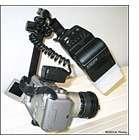Mark Plonsky - NPN 566
As a professor of experimental psychology (not entomology), I started scanning images in the late 1980’s for incorporating into my lectures. I began using a Canon Powershot G1 digital camera in 2000 for family photos and to document dog behavior. The camera was not as good as I would have liked for the latter, but it sure was fun. I liked the ability to try something and immediately see if, and how, it worked. The immediate feedback enabled me to learn quickly. Given my background, I tend to view the camera as a scanner that you point. In the 2 years that I owned the G1, I clicked the shutter over 25,000 times.
My interest in macro photography began when my son came into my office one day and talked me into taking a photo of an insect for him. We especially enjoyed how you could see even more in the image than with the naked eye.
When photographing bugs, I feel like a big game hunter. You have to work for that trophy and being able to track and stalk the game are skills that the hunter develops. I especially enjoy “dragon safaris” because dragon flies are abundant in my area at certain times of the year.
I prefer to photograph bugs in their natural environment. I don't chill them, spray them, glue them, or nail them down. This is noteworthy given that some setups I use require me to be only an inch or two from the bug. I will sometimes move some blades of grass or vegetation to get a better view. Even less often, I will relocate the bug to a new location (assuming it is cooperative). Nonetheless, they are always alive and well when I shoot them. My goal when photographing the bug is to show it as it naturally occurs and present it in a positive light. I especially like intimate portraits, behavior shots, and full body shots with clean and smooth (or at least interesting) backgrounds.
An aspect of my photography that surprises many is the cost of my equipment. I currently use a Canon Powershot G3 which is considered a prosumer, “point and shoot”, digital and sells for about $700. For macro photography, I use accessory lenses, including various diopters or close-ups (no special brands), a Tiffen 2x teleconverter (helps gain working
 distance when used after diopters), and a Pentax 50mm 1.4 for extreme macros (sometimes called “a poor man’s macro”). I attach the Pentax to the camera in the reverse position with a macro coupling ring. I also use a Canon 420ex flash with various Stofen diffusers and typically mount the flash on a Kirk butterfly bracket. I take most of my shots handheld because the bugs don’t often sit still and I put the camera in some awkward positions. I think this is one of the major advantages of a digital camera with a flip out LCD screen. Furthermore, the whole setup is very light weight. In fact, these are some of the reasons (besides the price and the all too rapid rate of obsolescence) that I have held off on purchasing a digital SLR.
distance when used after diopters), and a Pentax 50mm 1.4 for extreme macros (sometimes called “a poor man’s macro”). I attach the Pentax to the camera in the reverse position with a macro coupling ring. I also use a Canon 420ex flash with various Stofen diffusers and typically mount the flash on a Kirk butterfly bracket. I take most of my shots handheld because the bugs don’t often sit still and I put the camera in some awkward positions. I think this is one of the major advantages of a digital camera with a flip out LCD screen. Furthermore, the whole setup is very light weight. In fact, these are some of the reasons (besides the price and the all too rapid rate of obsolescence) that I have held off on purchasing a digital SLR.
In macro photography, the more the magnification, the less Depth Of Field (DOF). At high magnifications, the DOF is paper thin. I try to use what little there is as best as I can. I am told the small CCD of digital cameras gives me an advantage here.
My goal is to capture an image that will not need much “developing” in the digital darkroom. In reality, I find that such perfect images are few and far between. When working with the image digitally, my primary goal is to improve upon what the camera gave me and make the image look like it did in reality. Occasionally though, I will alter the image by adding clouds to a sky, cloning away unwanted portions of the background, performing selective sharpening, removing digital noise, removing aberrations of the light and/or lenses, etc. I also occasionally composite more than one image taken a second apart that have different planes of focus in an effort to increase DOF. I am most likely to do this with the more extreme macros because DOF is so limited there. Clearly, I believe that digital darkroom skills, just like traditional darkroom skills, are a valuable tool of the photographer.
Let me close by noting that I am a self taught amateur with an insatiable curiosity, fluent with technology, and willing to experiment. The Internet and photo forums such as NPN have been my photography teacher. Thus, I am especially thankful to those who have given me honest and constructive critiques, have shared/discussed images and techniques with me, and have inspired me with their images. In particular, I would like to thank Charlie Chein for inviting me to NPN.
Happy Hunting!
Editor's Note - Click any of the thumbnail images on this page to view a slide show of larger images. You can view more of Mark's work on his website at www.mplonsky.com/photo.
Comments on NPN macro photography articles? Send them to the editor.

